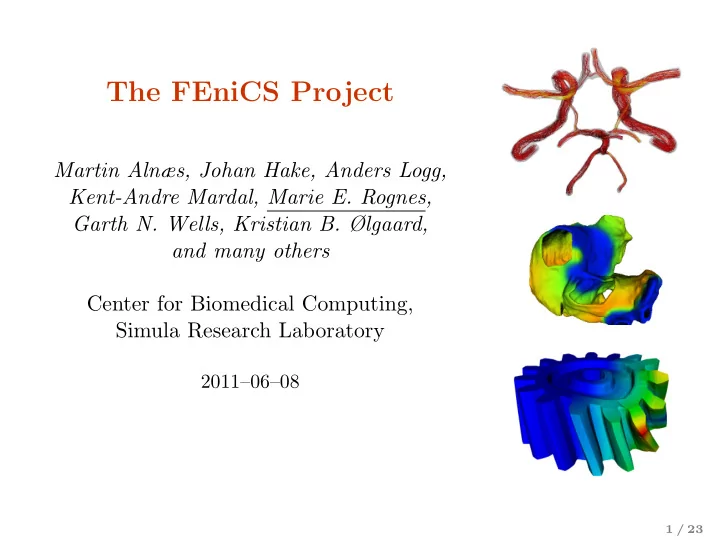

The FEniCS Project Martin Alnæs, Johan Hake, Anders Logg, Kent-Andre Mardal, Marie E. Rognes, Garth N. Wells, Kristian B. Ølgaard, and many others Center for Biomedical Computing, Simula Research Laboratory 2011–06–08 1 / 23
Automated solution of differential equations Output Input • A ( u ) = f � u − u h � ≤ ǫ • ǫ > 0 2 / 23
FEniCS is an automated programming environment for differential equations • C++/Python library • Initiated 2003 in Chicago • 1000–2000 monthly downloads • Part of Debian/Ubuntu GNU/Linux • Licensed under the GNU LGPL http://www.fenicsproject.org/ Collaborators University of Chicago, Argonne National Laboratory, Delft University of Technology, Royal Institute of Technology KTH, Simula Research Laboratory, Texas Tech University, University of Cambridge , . . . 3 / 23
FEniCS is new technology combining generality, efficiency, simplicity and reliability Generality Efficiency Code Generation • Generality through abstraction • Efficiency through code generation , adaptivity , parallelism • Simplicity through high level scripting , automation • Reliability through adaptive error control 4 / 23
FEniCS is automated FEM • Automated generation of basis functions • Automated evaluation of variational forms • Automated finite element assembly • Automated adaptive error control 5 / 23
6 / 23
Computational hemodynamics • Low wall shear stress may trigger aneurysm growth • Solve the incompressible Navier–Stokes equations on patient-specific geometries u + ∇ u · u − ∇ · σ ( u, p ) = f ˙ ∇ · u = 0 Valen-Sendstad, Mardal, Logg, Computational hemodynamics (2011) 7 / 23
Computational hemodynamics (contd.) # Define Cauchy stress tensor def sigma(v,w): return 2.0*mu*0.5*(grad(v) + grad(v).T) - w*Identity(v.cell ().d) # Define symmetric gradient def epsilon(v): return 0.5*(grad(v) + grad(v).T) # Tentative velocity step (sigma formulation) U = 0.5*(u0 + u) F1 = rho*(1/k)*inner(v, u - u0)*dx + rho*inner(v, grad(u0)*(u0 - w))*dx \ + inner(epsilon(v), sigma(U, p0))*dx \ + inner(v, p0*n)*ds - mu*inner(grad(U).T*n, v)*ds \ - inner(v, f)*dx a1 = lhs(F1) L1 = rhs(F1) # Pressure correction a2 = inner(grad(q), k*grad(p))*dx L2 = inner(grad(q), k*grad(p0))*dx - q*div(u1)*dx # Velocity correction a3 = inner(v, u)*dx L3 = inner(v, u1)*dx + inner(v, k*grad(p0 - p1))*dx • The Navier–Stokes solver is implemented in Python/FEniCS • FEniCS allows the solver to be implemented in a minimal amount of code Valen-Sendstad, Mardal, Logg, Computational hemodynamics (2011) 8 / 23
Tissue mechanics and hyperelasticity class Twist( StaticHyperelasticity ): def mesh(self): n = 8 return UnitCube(n, n, n) def dirichlet_conditions (self): clamp = Expression (("0.0", "0.0", "0.0")) twist = Expression (("0.0", "y0 + (x[1]-y0)*cos(theta) - (x[2]-z0)*sin(theta) - x[1]", "z0 + (x[1]-y0)*sin(theta) + (x[2]-z0)*cos(theta) - x[2]")) twist.y0 = 0.5 twist.z0 = 0.5 twist.theta = pi/3 return [clamp , twist] def dirichlet_boundaries (self): return ["x[0] == 0.0", "x[0] == 1.0"] def material_model (self): mu = 3.8461 lmbda = Expression("x[0]*5.8+(1-x[0])*5.7") material = StVenantKirchhoff ([mu , lmbda]) return material def __str__(self): return "A cube twisted by 60 degrees" • CBC.Solve is a collection of FEniCS-based solvers developed at the CBC • CBC.Twist, CBC.Flow, CBC.Swing, CBC.Beat, . . . H. Narayanan, A computational framework for nonlinear elasticity (2011) 9 / 23
Fluid–structure interaction • The FSI problem is a computationally very expensive coupled multiphysics problem • The FSI problem has many important applications in engineering and biomedicine Images courtesy of the Internet 10 / 23
Fluid–structure interaction (contd.) • Fluid governed by the incompressible Navier–Stokes equations • Structure modeled by the St. Venant–Kirchhoff model • Adaptive refinement in space and time Selim, Logg, Narayanan, Larson, An Adaptive Finite Element Method for FSI (2011) 11 / 23
Computational geodynamics − div σ ′ − ∇ p = ( Rb φ − Ra T ) e div u = 0 ∂T ∂t + u · ∇ T = ∆ T ∂φ ∂t + u · ∇ φ = k c ∆ φ σ ′ = 2 η ˙ ε ( u ) ε ( u ) = 1 � ∇ u + ∇ u T � ˙ 2 η = η 0 exp ( − bT/ ∆ T + c ( h − x 2 ) /h ) Image courtesy of the Internet 12 / 23
Computational geodynamics (contd.) • The mantle convection simulator is implemented in Python/FEniCS • Images show a sequence of snapshots of the temperature distribution Vynnytska, Clark, Rognes, Dynamic simulations of convection in the Earth’s mantle (2011) 13 / 23
14 / 23
Hello World in FEniCS: problem formulation Poisson’s equation − ∆ u = f in Ω u = 0 on ∂ Ω Finite element formulation Find u ∈ V such that � � ∇ u · ∇ v d x = f v d x ∀ v ∈ V Ω Ω � �� � � �� � a ( u,v ) L ( v ) 15 / 23
Hello World in FEniCS: implementation from dolfin import * mesh = UnitSquare(32 , 32) V = FunctionSpace (mesh , "Lagrange", 1) u = TrialFunction (V) v = TestFunction(V) f = Expression("x[0]*x[1]") a = dot(grad(u), grad(v))*dx L = f*v*dx bc = DirichletBC(V, 0.0, DomainBoundary ()) problem = VariationalProblem (a, L, bc) u = problem.solve () plot(u) 16 / 23
FEniCS (DOLFIN) class diagram 17 / 23
Implementation of advanced solvers in FEniCS Residuals FSISolver PrimalSolver DualSolver CBC.Flow CBC.Twist MeshSolver K. Selim, An adaptive finite element solver for fluid–structure interaction problems (2011) 18 / 23
19 / 23
FEniCS software components Applications FEniCS Apps Application Application Interfaces Puffin DOLFIN Core components SyFi Viper UFL UFC FFC FIAT Instant FErari External libraries PETSc uBLAS UMFPACK NumPy SCOTCH VTK Trilinos GMP ParMETIS CGAL MPI SLEPc 20 / 23
Automatic code generation 21 / 23
Combining it all with external libraries 22 / 23
Summary • Automated solution of differential equations • Simple installation • Simple scripting in Python • Efficiency by automated code generation • Free/open-source (LGPL) Upcoming events • Release of 1.0 (2011) • Book (2011) • New web page (2011) • Mini courses / seminars (2011) http://www.fenicsproject.org/ http://www.simula.no/research/acdc/ 23 / 23
Recommend
More recommend